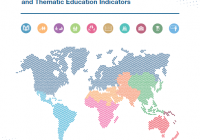With the adoption of the Sustainable Development Goals (SDGs), the UIS has been clearly recognised as the “the official source of cross-nationally comparable data on education”, as confirmed in the Education 2030 Framework for Action. The UIS has been given the mandate to “work with partners to develop new indicators, statistical approaches and monitoring tools to better assess progress across the targets related to UNESCO’s mandate, working in coordination with the Education 2030 Steering Committee”.
This mandate reflects the trust of the international community in UIS data and its proven track record in methodological work and standard-setting with national statistical offices, line ministries and technical partners in every region.
Key initiatives:
- Technical Cooperation Group (TCG): builds consensus on the SDG 4 measurement agenda and provides the opportunity for Member States, multilateral agencies and civil society groups to make recommendations to the UIS, which is responsible for coordinating the technical work needed to define and implement the global and thematic indicators;
- Global Alliance to Monitor Learning (GAML): provides concrete solutions to develop new indicators and sets standards for good practices in learning assessment by bringing together technical experts from a wide range of education stakeholders; and
- Inter-Agency Group on Education Inequality Indicators (IAG-EII): sets the standards across the UN system to report and interpret household survey data, especially in relation to measuring indicators on equity.
Key resources:
- SDG 4 Data Digest: provides a global perspective on initiatives and resources to help countries produce and use data to nurture learning;
- UIS Global Education Database: the official source of internationally-comparable education data, including SDG 4 indicators;
- SDG 4 Quick Guide: explains the development, production and interpretation of global indicators;
- SDG 4 Country Profiles: quick facts and global indicators in charts and graphs that are easy to understand;
- SDG 4 Data Explorer: presents data by sex, location and wealth with a series of parity indices;
- SDG 4 Data Book: Global Education Indicators 2018: updated on an annual basis;
- eAtlas for Education 2030: interactive maps and charts present the latest global and thematic indicators.
